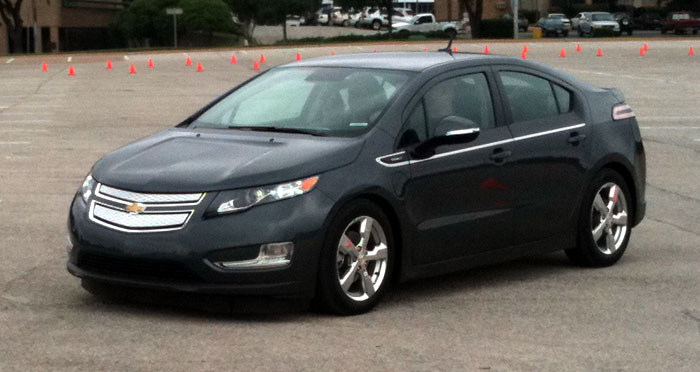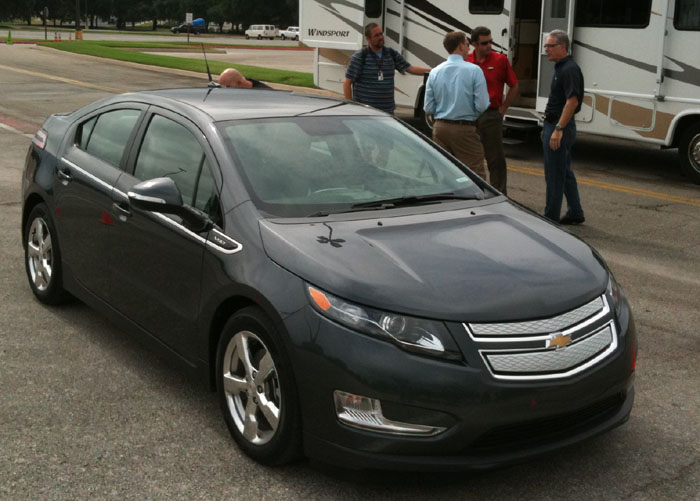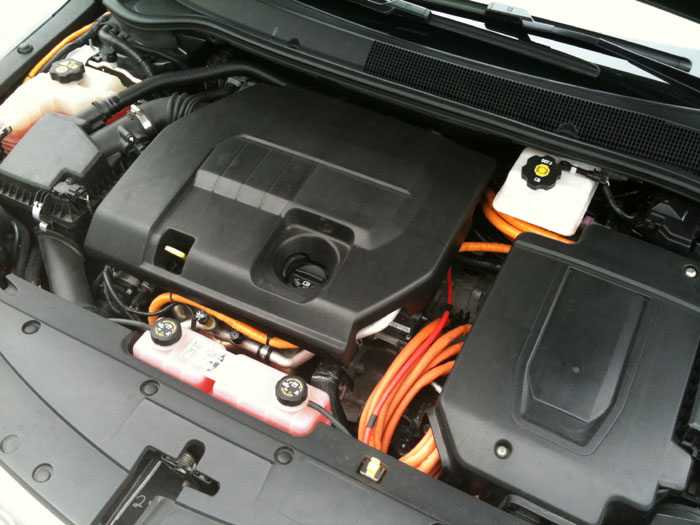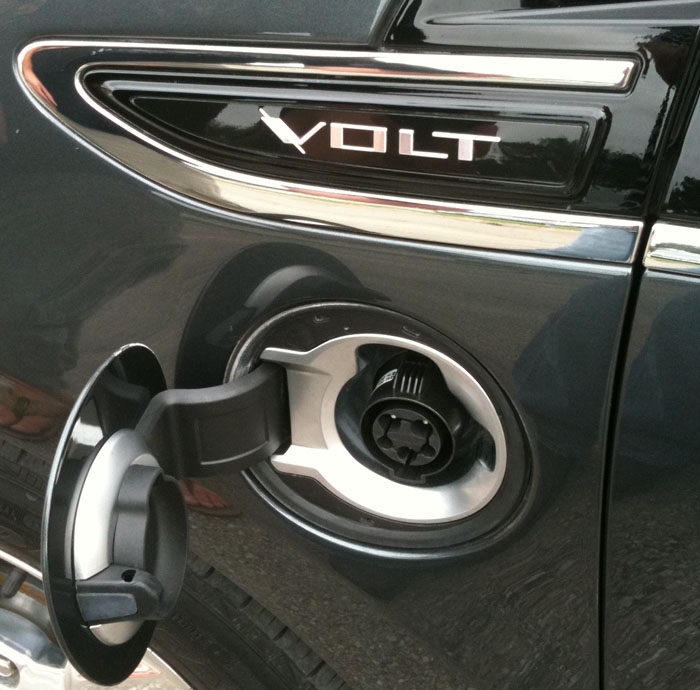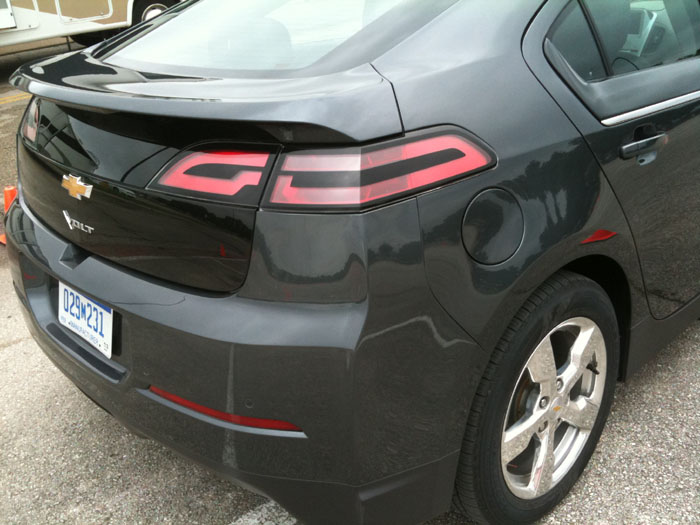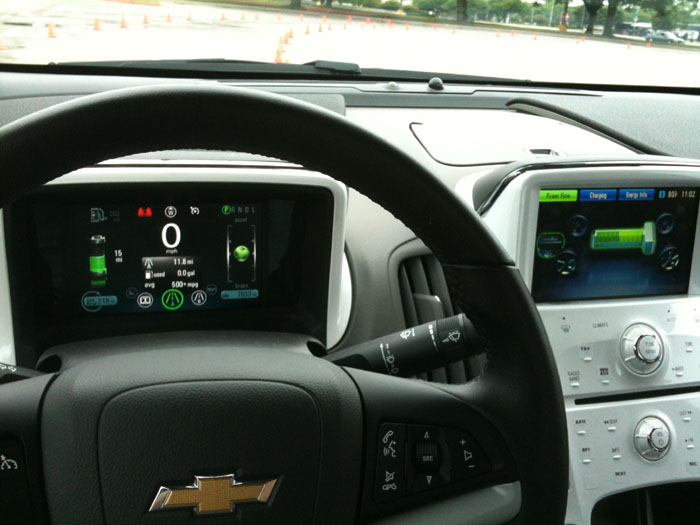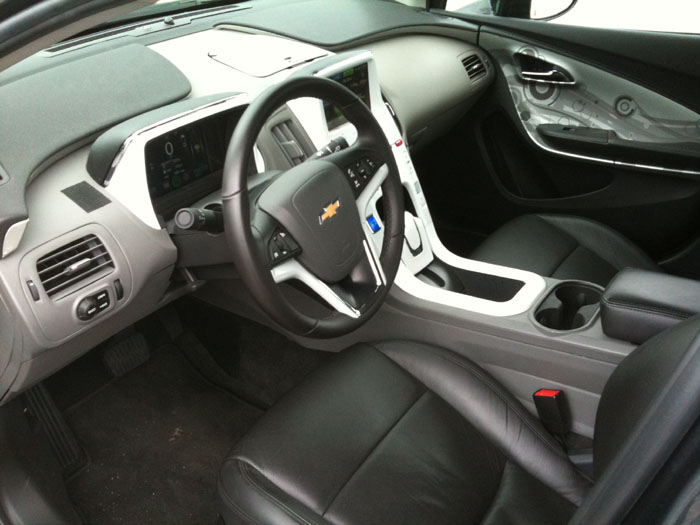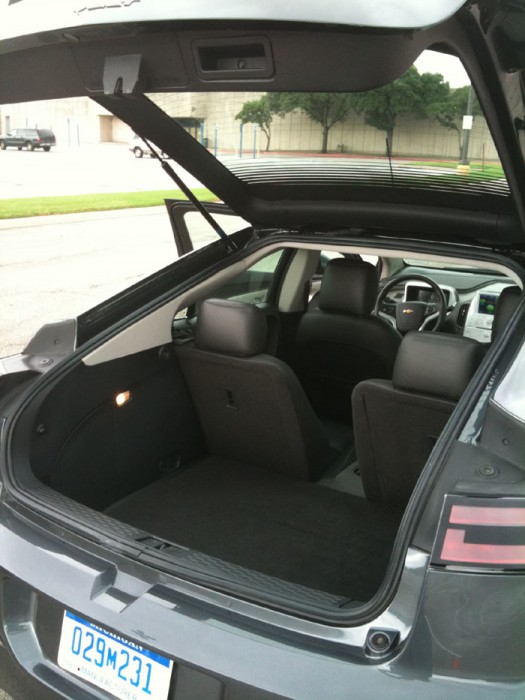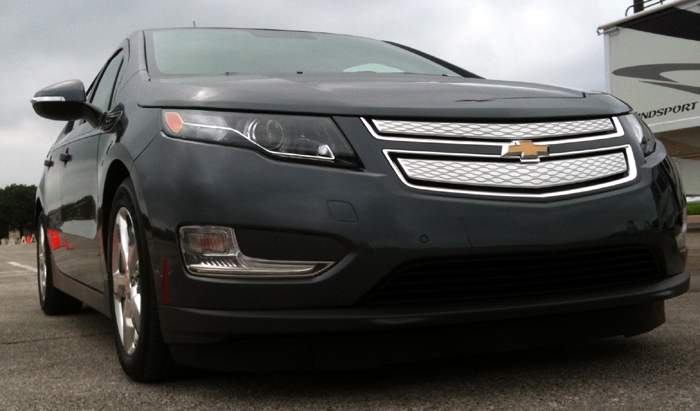Well, I did it. I drove the new Chevy Volt extended range electric vehicle that will be available later this year. What is it? In many ways it is similar to the current Toyota Prius hybrid. It features a battery pack that powers an electric motor that turns the wheels to make the thing go. It also has a combustion engine powered by gasoline that charges the battery pack when voltage drops too low.
Where it differs from the current breed of hybrid electric vehicle is that the combustion engine does not propel the Volt at all – it is completely disconnected from the drivetrain.
We were invited to Austin, Texas, to get a little seat time in the Volt. The tester was still a pre-production unit and we were reminded that some things could be subject to change between now and initial launch late this fall.
The Volt is built on a modified GM Delta global chassis (similar to that underneath the upcoming Cruze compact) and is a front-wheel drive four-seater with a hatch at the rear. The electric motor and the gasoline-powered generator are under the front hood and the new lithium-ion battery pack occupies the “transmission tunnel” running down the center of the vehicle front to rear. The electric drive unit generates some 16 kWh of power or about 150 horsepower and some 273 lb. ft. of torque. That torque can certainly be felt with a firm press of the accelerator pedal. Almost silently and instantly occupants are thrown back in their seating positions as if one were watching an action film with the volume turned way down.
The range of the battery pack is said to be approximately 40 miles on a full charge. And speaking of charge, make friends with your electric provider or, better yet, install a windmill in the back forty. The Volt re-charges on either 110 or 220 volts AC. A charging cord is supplied and stows in the rear cargo floor. It plugs into any conventional 110v outlet and through a converter box supplies the battery with DC voltage through a charging port in the front left fender that is hidden by a second fuel filler door.
When battery reserve drops too low while driving, the gas generator motor kicks on and starts sending electricity back to the pack. The range of the vehicle when including the generator motor is in the neighborhood of 300 miles. A small on-board fuel tank supplies the gas-powered generator. Final capacity of this tank has not been released but is said to be in the eight to nine gallon range.
Volt is not designed to be a long-range vehicle. It is focused at those who drive less than 40 miles in a day, which is said to be quite a few of us. Total recharge times are estimated at around three hours when using 220v and at least eight hours on a 110 line. A separate home charging unit will be necessary for folks wishing to hook up to 220 and if you don’t own the right type of smartphone you will be needing to set your alarm to wake you up in the middle of the night to plug your car in during the much cheaper off-peak hours for electric rates.
How does it drive? Pretty much like a hybrid vehicle running in full electric mode. Silent and peppy with a different brake and steering feel given they are controlled electronically instead of hydraulically. We did not get any highway time or high-speed passes in the Volt, our course was limited to a closed mall parking lot.
The vehicle features a traditional 12-volt system that powers all the vehicle lighting, audio and climate controls as well as the power windows and door locks. This battery is located under the rear cargo floor and is recharged by a separate generator that operates electrically.
A pair of LCD monitors come to life with the push of the ignition button, one in the center of the instrument panel and the other atop the center stack. Just above the ignition button is the switch to control drive mode. Drivers select between normal, sport and mountain settings. We found the mountain mode to automatically engage the onboard generator despite battery charge condition. This allows extra power reserve when climbing steep grades in the – wait for it – mountains. The sport setting was our choice as it enhanced acceleration response when “hitting the gas.”
With the radio turned down I could hear the gas generator when it was running. This was accompanied by a slight vibration as well. The electric drive unit emits a slight whine when under propulsion.
The Chevy Volt is not for the shadetree mechanic. There is very little, if anything, for the consumer to tinker with. And the new breed of electric vehicles are not for everyone. This is not a family vacation vehicle nor is it for the driver that needs to tow or haul. Electric drive vehicles are in their infancy so expectations should be kept accordingly. What was it Henry Ford said about a century ago? “You can have a Model T in any color you like as long as it’s black.”
And I don’t know if you have to unplug the Volt in a thunderstorm along with your flat panel TV but I would do so just to be on the safe side.
Pricing and exact release are still to be determined. Look for it late fall but only if you live in Motown, the Nation’s Capitol or the Golden State, but rumor has it some other launch locations will be announced soon.
Initial Specifications:
Model: 2011 Chevrolet Volt
Body style / driveline: five-door, front-wheel-drive sedan
Description: electric vehicle with extended-range capability
Key competitors: none
Manufacturing location: Hamtramck Assembly, Hamtramck, Mich.
Battery manufacturing location: Brownstown Township, Mich.
Performance
Top speed (mph): 100
EV range (city): up to 40 (based on EPA city cycle) actual mileage may vary depending on driving habits/conditions, weather and battery age
Extended range: 300 miles on a full tank of gasoline
Battery system
Type: lithium-ion
Energy: 16 kWh
Electric drive unit
Power (kW / hp): 111 / 150
Torque (lb-ft / Nm): 273 / 370
Charging times
120 V: about 8 hours (actual charge times may vary)
240 V: about 3 hours (actual charge times may vary)
Chassis/Suspension
Front: independent McPherson struts
Rear: compound crank twist axle
Steering type: electric power assist
Brakes
Type: four-wheel disc, fully regenerative to maximize energy capture
Wheels/Tires
Wheel size and type: 17-inch forged aluminum
Tires: specially developed low rolling-resistance
Dimensions
Exterior
Wheelbase (in / mm): 105.7 / 2685
Length (in / mm): 177 / 4404
Width (in / mm): 70.8 / 1798
Height (in / mm): 56.3 / 1430
Interior
Seating capacity (front / rear): 2/2
Capacities
Cargo volume (cu ft / L): 10.6 / 301
Fuel tank (gal / L): TBD
